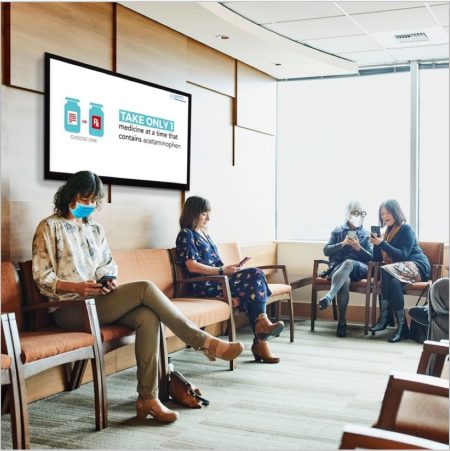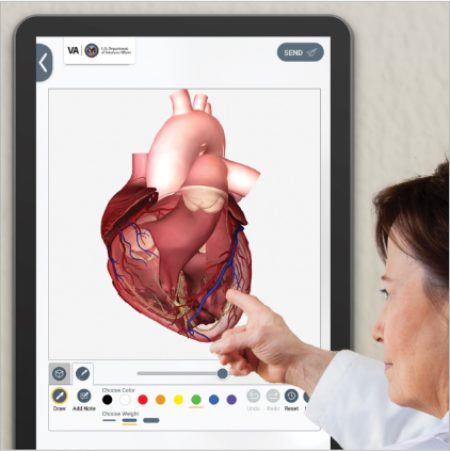

We think outside the box. Because we know that people can begin a positive health journey from anywhere.

The Foundation is actively involved in high-priority communities where the data on health metrics and patient outcomes shows a clear disparity. With the resources and support of our partners, we introduce proven technology and health education into the community. And PatientPoint Foundation is pioneering unconventional places to successfully engage a population and use technology and health literacy content to enhance lives.
We think outside the box. Because we know that people can begin a positive health journey from anywhere.
Key Strategies:
- Engage and mobilize any healthcare stakeholder who shares our vision of improving health equity.
- Leverage trusted resources in the communities we serve to help us connect with people and people to connect with providers.
- Leverage technology, health coaches, and health ambassadors to measurably improve the quality of care.
- Ensure Providers are conducting SDoH screenings so we can connect people to the appropriate support resources.
- Maintain an outcomes-based (not an activity-based) mindset.
- Employ best-in-class data analytics and outcomes analyses to track impact and refine approach.
Intended Health Outcomes
Improved health literacy where we have a footprint
Greater sense of empowerment as it relates to health
Increased healthy behaviors demonstrated
Greater engagement with health coaches and healthcare providers
Improved health metrics and health outcomes
Measuring Impact
Ultimately, the success of the Foundation will be measured by the longitudinal reduction in health disparities in the communities in which we work. This journey to success will include multiple phases (initial outcomes, intermediate outcomes, intended impact and ultimate goals).
We intend to measure the effectiveness of our partnerships and community relationships on a variety of qualitative and quantitative scores. We will conduct content impact analyses to evaluate the impact of our health education content on the health behaviors, and ultimately health outcomes, of our high-priority communities.

PatientPoint Foundation Communities

Cincinnati, Ohio
The Foundation is working on projects in communities across Ohio in partnership with established community stakeholders and neighborhood health centers. We will start focused, then scale our involvement to additional neighborhoods, cities and states.
The Village of Lincoln Heights
Lincoln Heights was founded in the 1920s as a suburb for Black homeowners. In 1946, it was incorporated as a village. Lincoln Heights was the first African American self-governing community north of the Mason-Dixon Line. Right now, the Village of Lincoln Heights is working on improving its infrastructure, health of residents, education, income equality, parks and recreation, maintaining a financially thriving community and providing job opportunities for the whole community.

Columbus, Ohio
The Foundation is also pursuing a priority community engagement project in North and South Linden through a valued partnership with Nationwide Children’s Hospital.
Linden Community
Situated northeast of Downtown Columbus, the Linden area is a historic neighborhood with about 18,000 residents. First developed as Linden Heights Village, the area grew into a bedroom community with a vibrant commercial district along Cleveland Avenue. Many challenges have persisted for decades in Linden, including lower-than-average health, employment, and education for its residents. The Linden community generally exhibits lower health indicators than the Franklin County average. Perhaps most striking, life expectancy for Linden residents is 8 years shorter than the Franklin County average.

Chicago, Illinois
The Foundation is working in collaboration with the Faith 1 Network, a group of 10 of the most historic and long-standing Black churches in Chicago, to establish a new initiative to bring vital health education and engagement to communities in Chicago’s South and West sides.
Bronzeville
A hub of Chicago’s Black culture, Bronzeville is home to more than 400,000 residents on the south side of the city.
The collaboration with F1N connects marginalized and under-resourced communities to the same health information and resources that are available in more affluent communities.
The program is supported with a Community Health Ambassadors program that gives the residents of the community and members of the F1N churches an opportunity to serve as champions for the cause of changing health trajectories by helping their neighbors achieve their best quality of life.

Your Community?
Interested in bringing Health Empowerment for All to your community through the PatientPoint Foundation?
PatientPoint Foundation Digital Displays

Education Platform Touchscreen
- Improve health outcomes with specialty-specific multimedia education and health information.
- Enhance patient-provider engagement with 3D anatomicals to help explain health conditions and diagnoses.
- Text or email education directly from exam room.

Education Platform Monitor
- Increase engagement around health and wellness with award-winning education, healthy living content, and messages from your community or organization.
- Customizable video loops with health education content, messages, and announcements most relevant to your community and your audience.

Remote Patient Monitoring
- Assist high-risk and chronic care patients’ health journey with easy-to-use remote monitoring devices.
“Improving health literacy alone could prevent nearly 1 million hospital visits. And save over $25 billion each year.” — The CDC
The Content


PatientPoint Foundation leverages and reapplies health education content that consistently merited Hermes awards, including a 2021 Hermes Creative Platinum Award. The content has been demonstrated to have a positive impact on patient behaviors and health outcomes. Most importantly, the content PPF employs has been shown to prompt individuals to more deeply engage in their own unique health journey.
• Understanding and adopting healthy behaviors
• Selecting a PCP and scheduling/keeping routine visits
• Health screenings and other pre-emptive health appointments
• Compliance with treatments and prescriptions
Resulting in (for example):
• A 20% increase in colon cancer screenings
• A 28% increase in flu vaccines
• A 43% increase in tobacco cessation counseling
Source: Results of matched pair analysis using longitudinal patient medical claims; 12-month total impact for colon cancer screenings and tobacco cessation, 3-month total impact for flu vaccines




